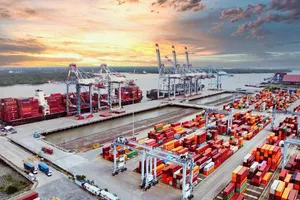 |
DBG Technology's base in Thai Nguyen Province. |
This move reflects the growing trend of Chinese businesses significantly increasing their production presence in Vietnam in recent years.
A wave of substantial investments
In March, Reuters reported that Vietnam had become a favored destination for a significant influx of investments from China following the country's decision to lift its zero-Covid policy in December 2022. According to data from the Ministry of Planning and Investment, Chinese companies had allocated the first 50 days of 2023 to invest in 45 new projects in Vietnam. These projects predominantly target well-established major brands that have already established their presence in Vietnam.
In fact, the presence of prominent corporations such as Samsung Electronics, Canon, and Apple in Vietnam has attracted equipment assemblers like Foxconn and Luxshare Precision, contributing to the swift growth of industrial clusters in various sectors such as smartphones and printers in Vietnam.
This time, Chinese companies are also being drawn to invest in constructing factories in Vietnam, aiming to provide materials and services to major corporations with an established presence in the country. As of May, Yicai Global, a Chinese publication, noted that numerous Chinese enterprises operating across various sectors, including textiles, optics, and telecommunications, have opened manufacturing facilities in Vietnam.
Gongjin Electronics, a provider of broadband terminal equipment based in Shenzhen, has invested nearly 400 million Chinese yuan ($57.5 million) to complete the construction of two phases for its factory in Vietnam. Yicai reported that once the third phase becomes operational, Gongjin Electronics' factory in Vietnam will have an annual production value of 10 billion Chinese yuan ($1.4 billion).
Likewise, DBG Technology, an electronics manufacturing service provider headquartered in Guangdong Province in Southern Huizhou, is gearing up to elevate its Vietnam branch to an overseas headquarters, capable of producing 40 million smartphones and other electronic devices annually within three years, accompanied by an annual export value of $4.5 billion.
Mr. Tang Jianxing, Chairman of DBG, has announced that the company has plans to hire and train around 15,000 workers in Vietnam. Additionally, it intends to establish a "multi-sector industrial supply chain" in Thai Nguyen Province, where several Chinese companies are already operating.
Furthermore, companies at different stages of the supply chain are enticing each other to invest in Vietnam for production collaboration. As an illustration, DBG has partnered with Huaqin Technology, a smart hardware manufacturer, and Lingyi iTech, a supplier for Apple, to establish an industrial park in Thai Nguyen Province.
According to the latest information from Reuters, Xiamen Hithium Energy Storage Technology and Growatt New Energy will invest approximately $1 billion in Vietnam. Xiamen Hithium has been working with Vietnamese officials and industry regulators and intends to invest $900 million to construct a factory on over 30 hectares of industrial land. Meanwhile, Growatt New Energy has already leased an existing manufacturing plant in Vietnam and is planning to allocate around $300 million to purchase approximately 15 hectares of industrial land for the establishment of a new factory.
Why Vietnam?
According to experts, Chinese businesses are increasingly expanding into Vietnam for several reasons. Firstly, Vietnam shares a border with China, facilitating convenient transportation of goods, raw materials, and production lines. Moreover, the Northern region of Vietnam, in particular, offers geographic proximity to China and competitive industrial land rental prices compared to the Southern region.
Vietnam's diverse geographical structure, encompassing mountains, plateaus, and coastal areas, is well-suited for the establishment of integrated economic zones. The country boasts an ample workforce, including a skilled labor force, and offers highly competitive labor costs. Additionally, the government has introduced a range of tax incentives to attract foreign investors.
Furthermore, Vietnam's high level of economic integration is noteworthy. To date, Vietnam has established economic and trade relations with around 224 partners from various countries and regions worldwide. This creates favorable opportunities for Chinese businesses in Vietnam to expand their market presence.
According to the South China Morning Post, Strategic Sports, a prominent global helmet manufacturer, plans to establish a smart factory in Vietnam in 2024, with a total investment of $30 million. The company views this strategic move as crucial for its survival, considering geopolitical factors. Norman Cheng, the owner of Strategic Sports, stated, "Our American customers have strongly encouraged us to relocate production to Vietnam. With their commitment to placing orders from Vietnam, we have decided to establish our presence in this country."
Choosing reliable investors
The recent surge in manufacturing relocation from China to Vietnam is a positive sign for the economy. However, experts emphasize the need for Vietnam to be discerning in its approach. It is crucial to ensure that foreign direct investment (FDI) companies generate job opportunities for local workers and contribute to training and technology transfer.
Still, it is essential to decisively decline projects involving outdated technology that can result in environmental pollution. Vietnam should also exercise caution to prevent becoming a mere "processing hub" for foreign companies utilizing its brand name for exports to Western countries.
To accomplish this, Vietnam needs to enhance its standards and criteria regarding the environment, resources, technology, standards, and product specifications. Moreover, there should be regulations in place to prevent Vietnamese organizations and individuals from serving as intermediaries in transactions related to land and real estate, as well as stricter oversight of lending activities between Vietnamese entities and foreign partners in real estate projects. At the same time, Vietnam should prioritize attracting investments into sectors that require capital infusion.
Vietnam is recognized as a promising destination for attracting investment relocations from China. However, to fully capitalize on this opportunity, Vietnam should develop specific and appropriate solutions that align with the global situation.
























